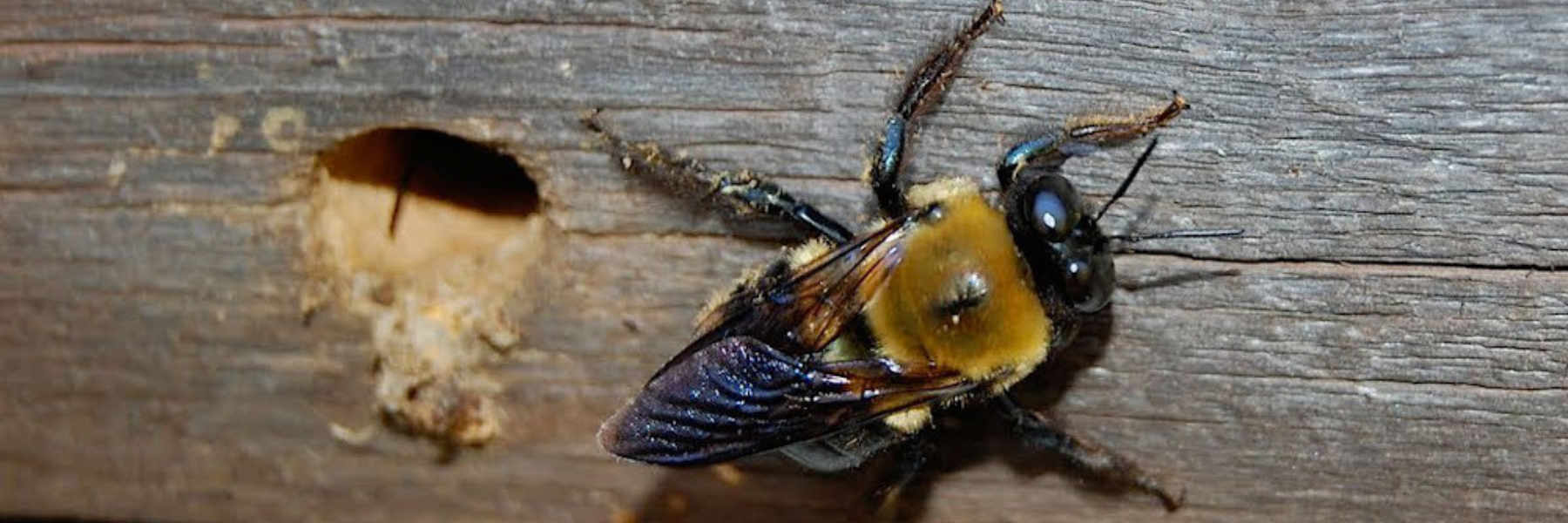Eastern carpenter bees are commonly found in Yardley, as well as throughout Pennsylvania and New Jersey. While these bees are beneficial pollinators of open-faced flowers, they can also cause problems.
Eastern carpenter bees damage wood structures in Bucks County by enlarging their nests, necessitating professional pest control to prevent further harm to your home in Yardley and Lower Makefield, PA.

| Feature | Description |
|---|---|
| Appearance |
|
| Habitat |
|
| Diet |
|
The eastern carpenter bee closely resembles the bumble bee, but with a hairless, shiny abdomen. Eastern carpenter bees range in size from ¼ to 1 inch in length, and can be yellow or black in color.
Carpenter bees gravitate towards specific wooded environments such as redwood, cedar, cypress, and pine. The bees are more capable of tunneling through woods that have a straight grain and are soft. The western species of carpenter bees frequently nest in redwood, eucalyptus, and oak. The insects use the wood to build nests.
Carpenter bees, particularly the eastern species common in Pennsylvania and Bucks County, create their nests by tunneling into wood. Here's what they typically target:
Common Structures: This often translates to them nesting in various parts of buildings and outdoor structures, such as:
It's important to note that while they prefer the conditions listed above, carpenter bees can sometimes nest in other types of wood if necessary.
Unlike termites, carpenter bees do not actually consume wood. Instead, they either discard the pieces of wood caused by boring or use them to create partitions within the tunnels. Like the honey bee, carpenter bees eat nectar and pollen. The female bees feed their larvae by placing pollen and regurgitated nectar within the cell of the brood.
Carpenter bees construct tunnels inside wooden overhangs, eaves, picnic benches, decks, shutters, shingles, or other areas around homes and businesses by creating 3/8-inch polished holes. Tunnels can range from 4-6 inches in length to as long as 10 feet when housing multiple bees. Initial damage is slight but can become major, reducing the integrity of posts, poles, and other items. This damage makes replacement necessary and can be costly. Another form of damage caused by carpenter bees is the laying of eggs. When this is done, the carpenter bee will return to the location where the eggs were laid year after year. This damages the wood located at the site. As with termites, damage caused by carpenter bees is not covered by standard insurance policies.
Carpenter bees tend to be very territorial and typically become aggressive at the sight of humans. Male carpenter bees will often hover close to the face of an intruder or begin buzzing near their head area. While the male carpenter bee does not possess a stinger and therefore poses no physical threat, the female carpenter bee can deliver a potent sting.
While the carpenter bee is not known to carry any diseases that are life-threatening, their stings can be serious.
One problem stems from the allergic reaction to mellitin, which is contained within the venom injected by carpenter bee stings. Mellitin is believed to engender allergic reactions.
Additionally, mellitin contains histamine and various other enzymes that can entail swelling and pain when the bee stings. In some cases, the sting from the bee can result in an allergic reaction that is life-threatening. The medical term for this condition is anaphylaxis.
When anaphylaxis occurs, the individual loses her or his airway and thus cannot breathe fully. If the reaction elevates, the airway can be lost completely, entailing shock and death in some cases. Other complications that can result from anaphylaxis include body hives, swelling, and itching.
Signs of a carpenter bee presence include yellow-brown excrement and pollen stains below entry holes, as well as wood shavings. Weakened structural wood is also a sign that may indicate the presence of carpenter bees. Having an inspection completed by a licensed pest management professional is the best way to detect the presence of carpenter bees in your living space.
To prevent carpenter bees from becoming a profound problem, a reputable pest control company such as Newtown Termite & Pest Control should be contacted. Part of the prevention process includes keeping exposed wood surfaces painted with an oil-base or polyurethane paint. This type of paint will prevent attacks from carpenter bees. Additionally, periodic examination should be performed to ensure surfaces have not weathered.
Proper carpenter bee control involves a series of steps, including the application of insecticides, dusts, and the sealing of existing holes. The selected insecticide is used as the initial form of treatment, followed by the injection of a specific dust formulation, which provides residual protection. Finally, entrance holes are plugged after the carpenter bee colony has been given sufficient time to distribute the treatment products throughout the nest area.
Newtown Termite & Pest Control utilizes a multi-faceted approach to eradicating the unwanted bees. When combined, the processes work together to ensure that your Yardley home or office remains a pest-free environment.
Schedule a FREE inspection today.
PEST PROBLEMS?
© Newtown Termite & Pest Control, Inc. since 1993
All Rights Reserved.